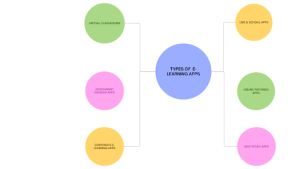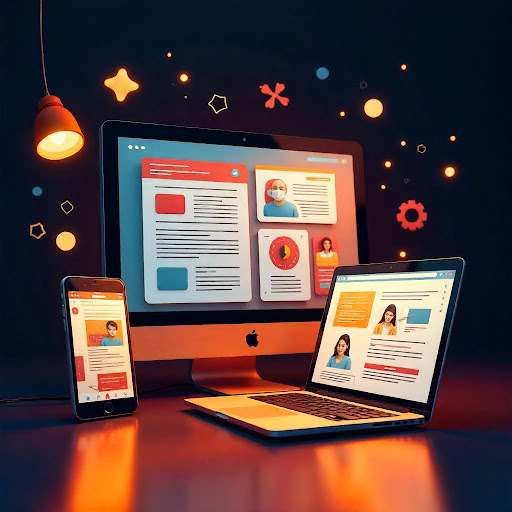E-learning app development: Ultimate trend in the market
Thinking to start a E-learning app development in 2026? Explore our guide for crucial insights on app types, and cost breakdowns, step-by-step guidance for e-learning app development in ‘26.

Introduction:
E-learning app development isn’t just a trend; it’s the future of education.
Here is an opportunity for entrepreneurs to seize the moment, to start e-learning app development in 2026.
In a rapidly growing digital world, the learning spectrum isn’t confined to just four walls. It’s about breaking down barriers, making knowledge accessible to everyone, and empowering learners to take control of their journey.
The need is immense, and the opportunity is yours. In this blog, you are going to learn about how to start an E-learning app development, from the types of e-learning apps, latest trends, cost to develop, and the key steps to follow, and also why e-learning is booming in recent times.
Content Overview:
-What is an E-Learning App?
-How many types of e-learning apps do we have?
-Latest Trends in the E-Learning Industry.
-How many stages of E-learning app development?
-How much does it cost for E-learning App Development?
-How much does it cost to build an EdTech App?
-Why is E-learning Booming?
-Similar E-Learning Apps.
-Conclusion.
-FAQS’
What is an E-Learning App?
An E-learning app is a software platform designed to deliver educational content and resources digitally.
It enables users to learn through various electronic devices such as smartphones, computers, and tablets. This app offers a range of features, including live or recorded lectures, interactive puzzles, quizzes, and online assessments, providing a flexible and accessible way to meet educational needs.
Now that we’ve defined what an e-learning app is, let’s explore the different types of e-learning apps available today.
How many types of E-Learning Apps do we have?
The E-learning app development market is vast.
Let’s dive into the various types of e-learning app features and how they serve different educational needs:

Virtual Classroom Apps:
Virtual Classrooms are designed to replicate the experience of a traditional classroom online.
They enable live interaction between students and teachers using audio and video calls, allowing real-time lectures, discussions, and doubt-clearing sessions.
Ex: Google Classroom, Zoom, Educate.
Assessment& Grading Apps:
Assessment grading apps help teachers grade assessments and tests, often providing immediate feedback on test results..
Ex: Quizlet, ZipGrade, Socrative.
Corporate E-learning Apps:
These apps are used by businesses to train their employees. They use videos, quizzes and other content to keep their staff informed with the evolving needs in business operations.
Ex: Docebo, EdApp, TalentLMS.
Learning Management Systems(LMS) & school Apps:
They are mostly used by schools and educational institutions.They help teachers and students create,store and manage educational materials and track student’s progress through the courses.
Ex: Moodle, BlackBoard Learn, Open LMS.
Online Tutoring:
These apps help students receive personalized learning from an instructor. This is done through recorded or live video sessions, where tutors can help students improve their skills and understanding of a subject.
Ex: Byju’s, Filo, Unacademy.
Self-Study Apps:
Self-study apps offer a flexible way for users to study at their own pace with features like pre-recorded videos, practice quizzes, and tools to track their personal progress.
Ex: Coursera, Udemy, edX
Latest Trends in E-learning Industry
Now that we’ve covered the foundational types of e-learning, let’s explore how the industry is advancing.
The E-Learning landscape is constantly evolving. To build an app that stands out, it’s crucial to look ahead. Here’s a look at the latest trends poised to redefine online education:
- Artificial Intelligence(AI)/Machine Learning(ML): AI is arguably one of the best upgrades in online education. Imagine having doubts cleared live from recorded sessions. How cool
- AI helps mobile learning apps in providing instant feedback, creating personalized learning sessions,
- tailored content, and live translations of video lessons for multilingual audiences.
- Meanwhile, ML helps in grading assessments, providing learning analysis to estimate overall progress, and providing personalized learning content to enhance learning drive and engagement.
Progress Analytics:
Most of the e-learning apps focus on just creating the course modules and assessments, which may not help students to keep track of their learning or the progress they made in assessments.
- Develop a space to track the amount of time spent, lessons completed, lessons to be completed, a performance measurement system, and an overall course analysis system.
Gamification:
Assume creating a mobile learning space where students could spend hours instead of doomscrolling social media.
- Gamification helps in developing game-based learning spaces through ranks, levels, points, rewards, and leadership features, which help in increased retention and healthy competition.
Cohort-Based Technologies:
This is one of the fast-growing trends in digital education.
By synchronizing a group of learners for a fixed time, it mimics the traditional classroom experience while leveraging digital tools to enhance live interaction, community support, and healthy competition.
Pro Tip: Conduct surveys, raise polls, ask students in real-time what they truly are looking for in an e-learning app rather than following the same track as everyone. Innovate something that really matters, and watch it stand out.
How many Stages For E-learning app development?
Ready to turn your e-learning app development vision into a reality? Here are the key steps for a successful e-learning mobile app development, from initial concept to launch and beyond:
1.Analyse Markets:
- First key step before planning and developing any app.
- Knowing your competitors helps you find the missing factors that they might lack which gives you a chance to stand out from others.
- Porter’s Five Forces is one of the best procedures to analyse competition in businesses.
2.Find your Target Audience:
Know your audience, look into their needs by their age.
This will help you plan the ground design of your app
And
- Most important step before initial E-learning app development.
- Knowing your audience by their needs, age and goals helps you plan the ground designing for your app.
- Conduct multiple surveys to find real-time problems faced so you can create tailored content according to the requirements.
3.TopNotch UI/UX Designs:
This is the face of your app, so you need to know your target audience. Also, this is where you get extra creative, so it is really important to choose the right UI/UX designers who align with your ideas.
In case you’re developing an app for kids, the designs are usually with bright, vibrant colours and funny elements to keep them on the hook.
But when it comes to adults’ apps, minimalist colours and fewer elements cause unnecessary distractions. So it is really recommended to choose the right UI/UX designers who actually get what you need and deliver high-end results.
4. Features of Minimally Viable Product (MVP):
This is like the first version of the application with the basic developments.
- It helps your app to enter a market quickly and also helps in highlighting the demand.
- Most startups use this to gain instant feedback from users for any improvements and test before any major upgrades to avoid wastage of investments.
5.Cloud Storage:
A key step in building an e-learning app is selecting the right cloud storage.
- It is important to prioritize robust security, fast performance, and a system that can easily handle growth while keeping user data private.
6.Development and Maintenance:
This is the stage where the app is built. It’s always best to hire experienced and skilled front-end and back-end developers.
- Front-end developers build the user-facing side of the app, while back-end developers are responsible for API and Database development.
- The development team typically handles maintenance and updates even after the app is launched.
7.Testing:
Quality Engineers(QA) test all the code and components, often performing both automated and manual tests to find any issues.
8.Launch:
This is the last step where your vision comes to reality.
- Make sure you come up with unique marketing strategies that align with your target audience.
- Analyze your competitors’ moves and run ad campaigns that clearly deliver your ideas in the market.
- Fund advertisements that translate your app’s main purpose in an innovative approach.
For more in-depth knowledge about e-learning app development , visit our blog for more insights on turning ideas into an app.
How much does it cost to build an EdTech App?
With the stages of development in mind, a critical question arises: How much does it cost to build a n EdTech App?
It usually depends on various factors. A basic app can cost as little as $15,000 while a complex, high-end feature app can easily exceed $300,000. But here are a few key factors listed below:
1.App Complexity and Features:
Basic Apps: Apps with simple quizzes or flashcards usually require features like registration, courselist, basic quizzes etc can cost you around $15,000 – $50,000.
Medium Complexity: Apps with Duolingo with features like video lessons, user profiles, simple gamification and payment gateways can cost you around $50,000 – $150,000.
High-End Complexity: Apps like Coursera or Udemy with full-fledged features like live video conferencing, advanced gamification, AI-driven personalized learning paths, chatboxes, advanced analytics, etc, can cost you around $150,000 – $500,000.
2.Platforms(iOS, Android, or Both):
Developing for a single platform is cheaper. But the cost can be doubled or could be much higher if you choose android(to support multiple models) or cross-platforms as developers use frameworks like Flutter or React Native as it is cost effective to deploy in both platforms.
3.UI/UX Design:
A clean and engaging design is a key component for keeping users engaged. You should budget for a custom, high-quality UI/UX design, as it’s essential for user retention and will add to the development cost.
4.Post- Launch Maintenance and Support:
This cost doesn’t end with the app’s launch. You will need to budget for:
- Bug Fixes and updates.
- Server Hosting and Cloud storage fees.
- Adding new features.
- Marketing and Promotion.
Why is E-learning app development Booming?
So, what makes the high cost of building an EdTech app worth it?
The answer lies in the incredible growth of the e-learning industry.Why is E-Learning Booming?
The global need for upskilling and reskilling is skyrocketing.
As you know, industries evolve rapidly. It offers flexibility,on-demand education appealing to students, professionals, and lifelong learners, as it is affordable and an alternative to traditional learning.
According to a report by Grand View Research, the global web-based learning market was valued at around $104.32 billion in 2024 and is expected to reach $334.96 billion by 2030, growing at a CAGR of 21.7% from 2025 to 2030, driven by demand for cost-effective learning solutions.

Now, let’s see some of the factors that are core reasons for the rapid growth of e-learning.
Need for Technological Advancements.
AI, VR, and adaptive learning platforms are transforming e-learning into personalised, interactive experiences. Tools like AI-driven tutoring or gamified learning increases engagement and retention, making platforms more effective than traditional methods.
Global Reach and Scalability.
Unlike physical institutions, online-learning platforms can serve a global audience with minimal marginal cost. Companies like Udemy can deliver courses to users in remote areas, tapping into emerging markets where access to quality education is limited. For example 50% of Coursera’s learners come from North America and Europe.
Cost efficiency for learners and providers.
E-learning eliminates expenses like physical campuses, travel or printed materials. For businesses, the low overhead of digital platforms means higher profit margins. Learners benefit from lower costs compared to traditional degrees.
Diverse Revenue models.
E-learning supports multiple monetization streams-subscriptions(e.g. MasterClass),freemium models(e.g. Duolingo), certifications, and B2B partnerships. This flexibility allows businesses to experiment and scale revenue quickly.
In short, e-learning’s combination of scalability, affordability and technological innovation positions it to meet the growing global demand for education and training, making it a lucrative and sustainable business opportunity.
Similar E-Learning apps
1. DuoLingo Click here.
Use: All-in-one app to practice new languages. Helps in enhancing reading, speaking, listening, vocabulary and grammatical skills.
Features: Gamified bite-sized lessons, AI role plays, community features, speech recognition .
2.Kahoot! Click here
Use: Transforms revision sessions into fun, gamified learning sessions through puzzles, polls and questions, used by all age students, teachers and professionals.
Features: AI tools, Folders and collections, team spaces, powerpoint integration, templates editing, real-time report, personalized learning.
3.Skillshare Click Here
Use: One-Stop learning app for creative skill developments with professional growth combined with project-based learning and networking opportunities.
Features: Subscription model, vast catalog, project-based learning, Community features, mobile and offline access.
4.Coursera Click Here
Use: Comprehensive digital learning space for career advancement and skill development through courses, degrees and certificates from top universities and companies.
Features: Multi-Lingual support, Offline access, credentials and recognition, flexible learning, progress tracking and personalization, subscription model.
Conclusion:
Build The Classroom Tomorrow
By building an innovative app, you’re not just creating a product; you’re building a tool that empowers people to learn, grow, and succeed on their own terms. Remember, the key to a successful e-learning app is a solid foundation-clear vision, focus on user experience, and a commitment to quality. By following these steps and embracing the latest trends, you can create a platform that not only stands out but also makes a lasting impact on the world of education.
Looking for Experienced Web/Mobile App Developers to start your dream E-learning app development ?WhiterApps is at your service!
We at WhiterApps, foster your ideas and help you create high-quality output with our top-notch web/app development services, UI/UX designing services, digital marketing services and more. Ready to start? Let’s build your e-learning app together. Book a free consultation to discuss your app ideas with our experts.
FAQS’:
- Is e-learning as effective as traditional classroom learning?
Research often shows that online-learning can be just as effective and sometimes even more so, especially when it is well-designed and interactive.
- How can you ensure the quality of an e-learning course?
Key indicators of quality include accreditation, a well-structured curriculum, engaging and interactive content and qualified instructors or course creators.
- Are online degrees and certificates accepted by employers?
Many people are concerned about the value of an online credential. The answer is generally yes, but it is crucial to verify that the institution or program is accredited and reputable.
Sources for E-learning app development:
https://www.grandviewresearch.com/industry-analysis/corporate-e-learning-market-report#
https://elearningindustry.com/how-to-build-an-elearning-platform
https://gloriumtech.com/e-learning-app-development-a-complete-guide/


